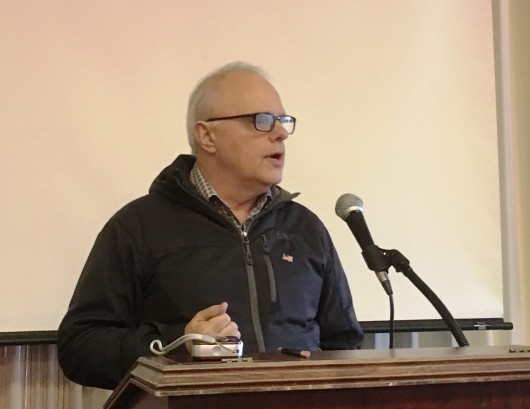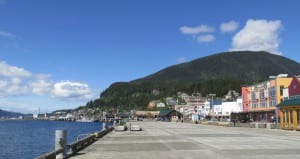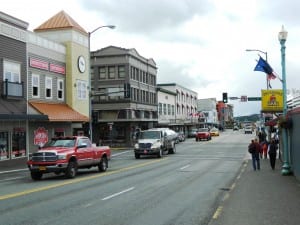
City of Ketchikan Mayor Lew Williams III gives what he says is his last “state of the city” presentation to the Ketchikan Chamber of Commerce. (Photo by Leila Kheiry)
In what he said will be his last “state of the city” address to the Ketchikan Chamber of Commerce, Mayor Lew Williams III vowed to be less grumpy. He also talked about the city’s need to accommodate larger cruise ships that will start arriving in the next few years.
Williams has been an elected City of Ketchikan official since 1987, and told the Chamber lunch audience that he’s been told he looks unhappy during meetings recently.
“My wife keeps saying every time she watches the meeting, my head’s down, I don’t look like I’m interested and I look grumpy,” he said, laughing.
Williams said he decided that’s an indication it’s time to take a break from local politics. He will finish out his term as mayor this year, and said he won’t seek re-election.
Williams detailed a project the city is looking into: expansion of the downtown port, where cruise ships tie up during the busy summer months. Williams said cruise ships have reconfigured where their lifeboats are located for safety reasons, and new, larger ships soon will start arriving in the Alaska market.
He said the fixed dock at Berths 1 and 2 won’t work with the new lifeboat configuration, because of the large tides here. And once the bigger vessels start arriving, the current facilities will not be able to fit as many ships at one time.
Williams said tourism through the cruise industry is a top economic factor in Ketchikan.
“It’s a great industry,” he said. “It’s our No. 1 industry, practically, that we deal with right now in our community and we want to be ready for it.”
In a special meeting, the City Council discussed recommendations for expanding and improving the port. Those plans will take some time to finalize and implement.
The Council did agree to move forward with a recommended refurbishment of the Berth 3 barge, and dredging a rocky pinnacle in the Tongass Narrows that can be a navigation hazard.
Williams stressed that any big improvements to the port should be paid for through cruise passenger head taxes.
The city this year also will do some “sprucing up” on the dock. Williams said they’ll have new planters; and the port will hire musicians to play at the Berth 3 shelter during the upcoming season.
Williams talked briefly about the two marijuana stores that will open sometime this spring. One is on Stedman Street and the other is on Water Street.
“And they’ll be providing sales for everybody, including tourists,” he said. “I don’t know how it’s going to work with sales and getting on boats, but these guys are working to get their shops going and so we will be seeing that activity this summer. What kind of sales tax is coming, I don’t know.”
The city has imposed a 5-percent sales tax on marijuana, which is on top of the normal city and borough sales tax rate of 6.5 percent. If cruise ship do purchase marijuana and try to take it on board the ships, they risk getting kicked off because pot isn’t allowed on board.
A big project that is due to start this fall is the state Department of Transportation’s
repaving of Front, Mill and Stedman streets downtown. Williams said the first phase will be widening and improving sidewalks along that corridor, and that work should be done before next year’s cruise season.
The street work will begin right around the same time that cruise ships start arriving in 2018, but, Williams said, it will be scheduled in a way to reduce the impact.
“And they’ll do no more than one or two sections at a time, but the best thing they’re going to do is, they’re going to do it at night,” he said. “There might be a little noise for people downtown and I hope it’s not too bad, but I think doing it at night will make a big difference, especially the impact of all the ships coming into town, which is enough congestion already.”
Another ongoing DOT project is replacement of the trestle on upper Water Street, which will continue for a couple more years. It’s a complicated project, and is inconvenient for residents of that area. But, Williams said, once it’s done, the new trestle should last a long time.
 Williams said one issue the City Council will tackle this year is water rates, and how to make those rates less of a burden on residential customers. Now, residential users pay significantly more for water than large industrial customers, essentially subsidizing those businesses.
Williams said one issue the City Council will tackle this year is water rates, and how to make those rates less of a burden on residential customers. Now, residential users pay significantly more for water than large industrial customers, essentially subsidizing those businesses.
“So, we’re trying to balance that so we’re not dumping on all the residential — so the people that use the water are paying for it,” he said. “We’ve had to put in a lot of things with the water system, chloramines and everything else. I think it’s costing us $2.77 per thousand gallons, so we need to cover those costs. Water’s always been tough. That’s an issue you’re going to see talked about: Where we’re going to go with that.”
Williams also noted that the city’s Tongass Historical Museum at the Centennial Building is finishing up its remodel project, and museum staff have started planning for a new permanent exhibit.







